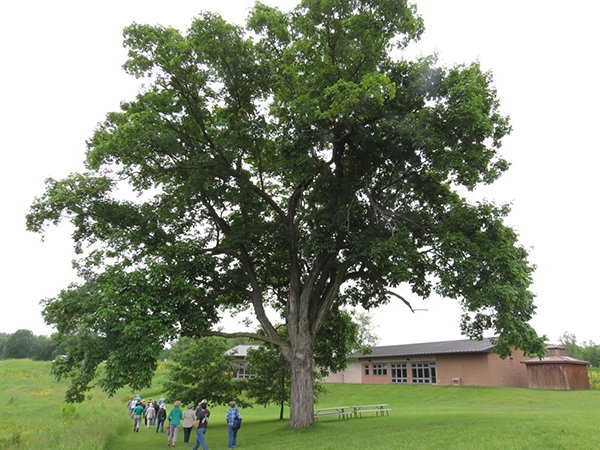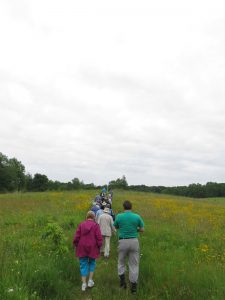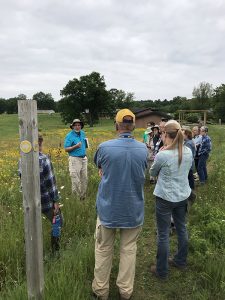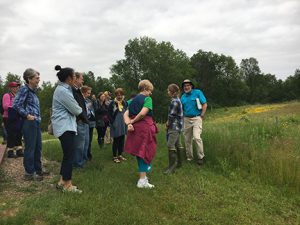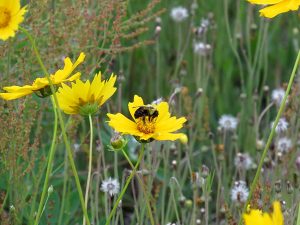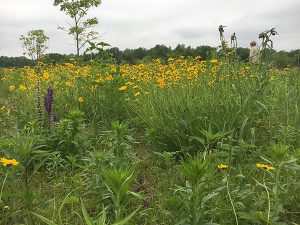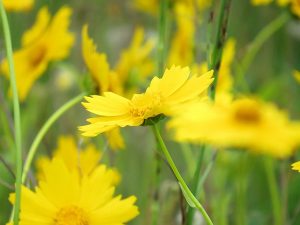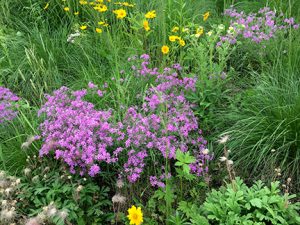JUNE 17, 2019 PROGRAM RECAP
by Ruth Oldenburg, Communication Chair
If We Build It They Will Come: Research Results on Prairie Management
Presented by Dr. Rob Keys, Professor of Science, Cornerstone University
 It was an overcast evening, and 16 Wild Ones members made the hour drive to the Pierce Cedar Creek Institute near Hastings. Enthusiasm was high right on arrival as we were delighted to see so many species blooming at the entrance near their sign and covering the building’s berms. The golden yellow Sand Coreopsis was the dominant species mixed with Wild Lupine, Wild Columbine and Prairie Smoke among many others.
It was an overcast evening, and 16 Wild Ones members made the hour drive to the Pierce Cedar Creek Institute near Hastings. Enthusiasm was high right on arrival as we were delighted to see so many species blooming at the entrance near their sign and covering the building’s berms. The golden yellow Sand Coreopsis was the dominant species mixed with Wild Lupine, Wild Columbine and Prairie Smoke among many others.
We were greeted by Dr. Rob Keys, Professor of Science at Cornerstone University and he introduced us to the Institutes’s Stewardship Coordinator, Rickie Oldenkamp, and research students Jess and Cory.
This is Dr. Keys’ 15th year of conducting research at Pierce Cedar Creek Institute (PCCI) during the summer months. He has led research students for five years. The first year, the students mapped out the entire acreage.
 Dr. Keys specializes in the study of birds. He showed us photos of the six “obligate” grassland birds—those that nest only in grasslands. Eastern Meadowlark, Bobolink, Dickcissel, Henslow’s Sparrow (State Endangered), Grasshopper Sparrow, and Savannah Sparrow. Grassland birds depend on insect diversity to feed their young. They nest in the grass out of sight from their predators. But the problem was that none of these species were nesting in PCCI grasslands.
Dr. Keys specializes in the study of birds. He showed us photos of the six “obligate” grassland birds—those that nest only in grasslands. Eastern Meadowlark, Bobolink, Dickcissel, Henslow’s Sparrow (State Endangered), Grasshopper Sparrow, and Savannah Sparrow. Grassland birds depend on insect diversity to feed their young. They nest in the grass out of sight from their predators. But the problem was that none of these species were nesting in PCCI grasslands.
Ironically, they found that Henslow’s Sparrows were nesting in nearby old fallow farm fields, where they counted 70 singing males. At the Kent County Airport, 60th Avenue to the viewing area on Kraft, is a one-mile long grassland where they have seen many Bobolinks and Henslow’s Sparrows.
PCCI has reconstructed four prairies of 20-25 acres each on the property in hopes that as in the Field of Dreams movie (“If you build it they will come”) the biodiversity of insects, birds and plants would increase. While the plant and insect biodiversity has increased, Keys reported that the obligate bird population has not.

Dr. Keys’ (pictured left) goal was to find out why. He has two hypotheses: first, that birds don’t recognize PCCI grasslands as a good habitat, or that, second, some feature is making the grassland unattractive to birds.
We walked around the first prairie which had been drill seeded with forbs and totally burned in year two. Dr. Keys explained that prairie seed mixes are heavy on 3 species of warm-season grass, Indian Grass, Big Bluestem and Switchgrass. Since these grasses are inexpensive they comprise the majority of seed in prairie mixes. 40–50% is typically Big Blue Stem. The warm-season grasses tend to take over the forbs, so drill seeding would greatly increase forb diversity.
The problem with Big Bluestem is that when their stiff canes fall they form a dense mat which is a problem for obligate birds. These birds like to run through the grass to escape predators. But the dense mats of Big Bluestem canes make it difficult for them to run through. So by decreasing the biomass by burning or mechanically chopping it, makes the prairie more suitable for obligate birds. In the past, in the Great Plains, the warm season grasses didn’t get out of hand because Buffalo and other grazers kept it shorter. Also, natural burning took place started by lightning. Research student Cory is doing his Capstone project on burning practices.
A question was asked about the possibility of grazing at PCCI prairies. Dr. Keys said he would choose cows over sheep to graze as a way to keep the prairie in check. Sheep are indiscriminate eaters—they eat everything. Dr. Keys explained that he visited Ireland where cows graze on the dunes. Ecologists thought that the cows would ruin the dune’s biodiversity so they banned the cows from the dunes. This was a mistake, the dunes suffered without the cows because cows are discriminate eaters. They eat only grass making way for the forbs to grow. They brought the cows back to the dunes to graze and over time the biodiversity returned. Cows, however, are not practical at PCCI because it is public land with people using it.

Jess explained that she goes out from 6:30–10:30 am and records a bird count on her iPad. They have recorded 6 Henslow’s Sparrows so that is a good sign that the adding of more forbs and burning the biomass is helping. Prescribed burns are done at PCCI every 3–5 years. Tree seedlings are reduced. Mechanical mowing is done in the Fall.
PCCI is located on a prairie/hardwood transition zone. In the past, there were more Oak Savannahs in the area than prairies. The Schoolcraft area used to be home to large prairies that are now farmland.
We learned that semi-obligate birds, such as Song Sparrows, Field Sparrows, and Common Yellow Throats, like the edges of prairies.
Next, we viewed their second prairie where the PCCI team has taken a different approach. This prairie was mechanically disked and hand broadcasted with forbs in a Fall planting. Here Jess explained that they do tests with a 50 cm x 20 cm Daubenmire frame made of PVC pipe. They collect all the plant material within the frame, shred it, dry it, and weigh it to determine the weight of the biomass. (Biomass is the weight of the mass minus the water). They also use a sweep net and walk 20 meters swinging a net back and forth, collecting all the insects in that area and then freezing them for study.
It was getting late, so we were unable to walk to the third prairie, but Dr. Keys talked a bit about it. This prairie is managed by rotation mowing with a flail mower. To simulate grazing, 1 hectare (10,000 sq. meters) a week is mowed. The researchers mark the bird’s nests before they mow. Then a large swath is left around the nests.
In a fourth area, they are recreating an Oak Savannah. The area was formerly a soybean field. They planted oak trees in the Spring.
Take away:
Recreating prairies does greatly increase the biodiversity of plants, insects, and pollinators. But for grassland birds, “building it does not make them come.” Prairies need to be managed.
Dr. Keys hopes that their research becomes a model that can help others.
We thank Dr. Keys, his students, and Rickie Oldenkamp of PCCI for a fascinating look at prairie management.
Photos by Valerie Lindeman, Gabrielle Tremblay Sullivan, and Ruth Oldenburg

